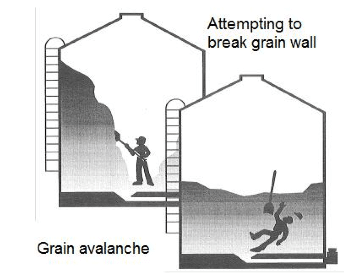
Please be careful when climbing grain bins to open hatches or probe them, when using grain handling equipment, and while transporting grain.
And certainly try to avoid entering bins to help improve grain flow and break crusting. Manitoba’s Safe Farms program provides the following tips on how to control the hazards from its “Flowing Grain Entrapment” factsheet:
Entrapment in flowing grain:
—Take precautions to prevent falling into grain bins. DO NOT overreach into bin openings.
—Wear appropriate personal protective equipment (PPE) when working with grain (e.g. respirators, eye protection, etc.).
—Ensure anyone required to enter a bin uses a body harness connected to a lifeline, secured to the outside of the bin.
—Train workers, family members, and visitors to your farm (e.g. contractors) on the dangers of flowing grain.
—Place warning decals or signs indicating “Danger: Flowing Grain Hazard” on all bin entrances and grain holding structures, including grain carts and truck boxes.
—Turn off and lock out power controls on unloading devices before entering bins.
—Develop and put in place a written entry and rescue plan.
—Never work alone. Have at least two additional workers or family members trained in rescue and confined space safe work procedures at the bin to assist in case something goes wrong.
—Keep children off of grain vehicles and out of bins at all times.
—Install ladders inside and outside of bins.
Grain bridge collapse:
—To detect a grain bridge, look for an upside-down cone or funnel shape after unloading grain from a bin. If the surface of the grain is undisturbed, it has bridged and there is a hollow cavity under the surface.
—Do not enter the bin to break the bridge loose or attempt to stand on the grain.
—Use a pole from outside the bin to collapse the bridged grain. Tie the pole to a rope tied to the bin in order to retrieve the pole.
—Use proper grain storage techniques to avoid conditions that cause spoilage.
Collapse of a vertical grain wall:
—Do not enter a bin to break down walls of grain.
—Break grain walls from outside of the bin using long poles.
—Be prepared that a grain wall can break free at any time.
—Use proper grain storage techniques to avoid conditions that cause spoilage.
